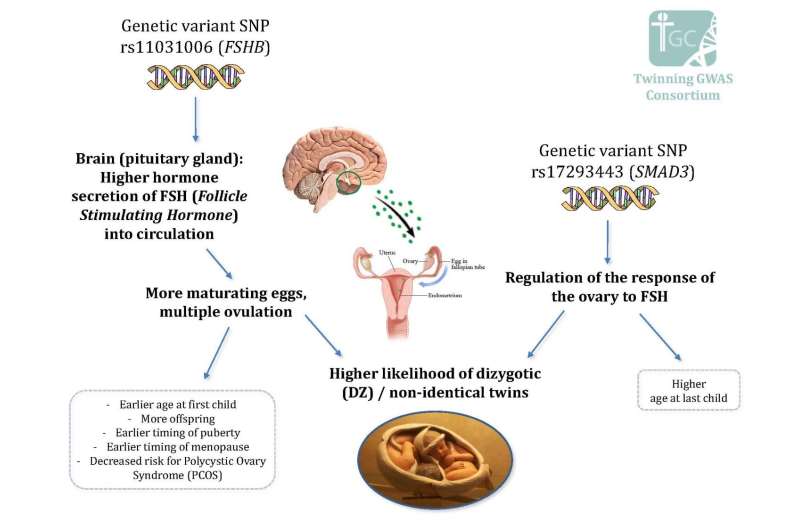Researchers find genes that influence dizygotic twinning and fertility

Twinning has fascinated human beings over the centuries. Twins are relatively common and occur more than 1 time per 100 maternities. Roughly two-thirds of all twin pairs are dizygotic or non-identical and are genetically as alike as other siblings. It has been firmly established that dizygotic twinning has a maternal genetic component, but no one so far has succeeded in identifying the genes for spontaneous DZ twinning after decades of investigations.
An international collaboration on the genetics of dizygotic twinning led by Dr Hamdi Mbarek and Prof. Dorret Boomsma from the Vrije Universiteit Amsterdam has obtained a breakthrough in identifying genes that increase the chance for mothers to have dizygotic twins. One of these genes also has significant effects on fertility measures, including the age of a girl's first menstruation, age at menopause, number of children, and age at first (and last) child, but also on polycystic ovary syndrome, which is a major cause of infertility in women.
The findings appear online today in the prestigious international scientific journal The American Journal of Human Genetics. Researchers believe the findings represent a significant advance in the identification of key mechanisms controlling ovarian function and provide a greater understanding of female fertility and infertility.
Mbarek and colleagues report two genetic variants. The first variant is close to the gene coding for the secretion of follicle stimulating hormone (the FSHB gene) by the pituitary, the small brain organ that governs almost all major hormonal events in the body. The second variant relates to the so-called SMAD3 gene and is likely to be involved in the way the ovaries respond to follicle stimulating hormone. Both variants result in the multiple follicle growth that is obviously needed for the development of non-identical twins. Non-identical twins develop from 2 separate eggs from separate follicles fertilized by separate sperm cells. Whereas identical twins develop from one embryo that splits in half, dizygotic twinning thus starts with a multiple ovulation, a maternal characteristic.
The research brought together a large number of mothers who gave birth to spontaneous dizygotic twins. The mothers were carefully chosen not to have received fertility treatments, such as IVF, which may also lead to twin pregnancies. Their genetic profiles were compared to those from a large group of people who were not related, either as mothers or as family members, to dizygotic twins. An important strength of the study was that the findings were replicated by the famous deCODE group in another large population cohort from Iceland.
The relative risk of a mother having dizygotic twins is increased by 29% if she has one copy of the twinning gene (or alleles) at both contributing locations in the genome.
"Discovery of the main genes behind the mystery of spontaneous dizygotic twinning was long awaited, and is of great scientific interest and clinical importance", said senior author Prof. Dorret Boomsma, Ph.D., who specializes in genetics and twin studies and who has worked on the genetics of twinning for most of her career.
"The results will be of importance to investigate ovarian response to hormone stimulation for assisted reproduction such as In Vitro Fertilization (IVF), making the findings also of great interest to research into female infertility", said Prof. Nils Lambalk, Prof of Reproductive Medicine at VU Medical Center who is involved in the study.
There are still more genes to be found that influence spontaneous DZ twinning. A genetic risk score based on other variants but excluding the top findings, still additionally predicts dizygotic twinning and having children Mbarek and colleagues found.
"In the future, developing a simple genetic test based on the top hits could assist in the identification of women at risk of a high response to hormonal treatment and allow calibration in order to prevent the severe complication of ovarian hyperstimulation syndrome with IVF", said first author Dr. Hamdi Mbarek, Ph.D., the lead researcher on the paper, who also works at the department of Biological Psychology at the Vrije Universiteit in Amsterdam. The department established the Netherlands Twin Register nearly 30 years ago and questions about the etiology of twinning are among the most frequently asked by the participants.
More information: American Journal of Human Genetics, Mbarek et al.: "Identification of common genetic variants influencing spontaneous dizygotic twinning and female fertility" DOI: 10.1016/j.ajhg.2016.03.008 , www.cell.com/ajhg/fulltext/S0002-9297(16)30043-X

















